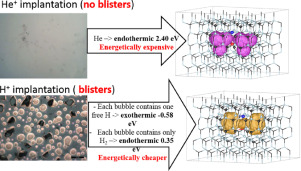当前位置:
X-MOL 学术
›
Acta Mater.
›
论文详情
Our official English website, www.x-mol.net, welcomes your
feedback! (Note: you will need to create a separate account there.)
The structural evolution of light-ion implanted 6H-SiC single crystal: comparison of the effect of helium and hydrogen
Acta Materialia ( IF 8.3 ) Pub Date : 2020-04-01 , DOI: 10.1016/j.actamat.2020.02.046 N. Daghbouj , B.S. Li , M. Callisti , H.S. Sen , J. Lin , X. Ou , M. Karlik , T. Polcar
Acta Materialia ( IF 8.3 ) Pub Date : 2020-04-01 , DOI: 10.1016/j.actamat.2020.02.046 N. Daghbouj , B.S. Li , M. Callisti , H.S. Sen , J. Lin , X. Ou , M. Karlik , T. Polcar

|
Abstract The microstructure evolution of hydrogen-implanted 6H-SiC at different temperatures and fluences is investigated by using various experimental techniques. In H-implanted samples with relatively low fluence at RT, dense blister cavities are observed after annealing at 1100 °C, while no visible blister cavities appear after annealing at 1100 °C in the sample implanted at RT with high fluence. The absence of blister cavities is due to the loss of elastic energy during the crystalline-to-amorphous transition. With a further increase of implantation temperature to 450 and 900 °C, amorphization did not occur and H-containing microcracks grew laterally below the surface. Thus, blisters appeared on the surface of the samples implanted at 900 °C even without annealing. The results are compared to the microstructural evolution of He-implanted 6H-SiC which was explored in our previous work. The behavior of hydrogen and helium ions in 6H-SiC lattice was rather different. For He implantation, regardless of the fluence and implantation temperature, blisters did not form. The mechanism of migration and coalescence of nanoscale bubbles that are responsible for blistering were studied via density functional theory calculations, which well-supported the presented results. We found that both mechanisms (migration and coalescence) are energetically cheaper in the case of H compared to He.
中文翻译:

轻离子注入6H-SiC单晶的结构演化:氦气和氢气效应对比
摘要 利用各种实验技术研究了不同温度和能量密度下氢注入 6H-SiC 的微观结构演变。在室温下注量相对较低的 H 注入样品中,在 1100°C 退火后观察到致密的气泡腔,而在室温下注入高通量的样品中,在 1100°C 退火后没有出现可见的气泡腔。没有泡孔是由于在晶体到非晶态转变过程中弹性能量的损失。随着注入温度进一步提高到 450 和 900 °C,没有发生非晶化,含 H 微裂纹在表面下方横向生长。因此,即使没有退火,在 900°C 下植入的样品表面也会出现气泡。将结果与我们之前工作中探索的 He 注入 6H-SiC 的微观结构演变进行了比较。氢和氦离子在 6H-SiC 晶格中的行为相当不同。对于 He 注入,无论注量和注入温度如何,都没有形成水泡。通过密度泛函理论计算研究了导致起泡的纳米级气泡的迁移和聚结机制,这很好地支持了所提出的结果。我们发现,与 He 相比,H 的两种机制(迁移和聚结)在能量上都更便宜。通过密度泛函理论计算研究了导致起泡的纳米级气泡的迁移和聚结机制,这很好地支持了所提出的结果。我们发现,与 He 相比,H 的两种机制(迁移和聚结)在能量上都更便宜。通过密度泛函理论计算研究了导致起泡的纳米级气泡的迁移和聚结机制,这很好地支持了所提出的结果。我们发现,与 He 相比,H 的两种机制(迁移和聚结)在能量上都更便宜。
更新日期:2020-04-01
中文翻译:

轻离子注入6H-SiC单晶的结构演化:氦气和氢气效应对比
摘要 利用各种实验技术研究了不同温度和能量密度下氢注入 6H-SiC 的微观结构演变。在室温下注量相对较低的 H 注入样品中,在 1100°C 退火后观察到致密的气泡腔,而在室温下注入高通量的样品中,在 1100°C 退火后没有出现可见的气泡腔。没有泡孔是由于在晶体到非晶态转变过程中弹性能量的损失。随着注入温度进一步提高到 450 和 900 °C,没有发生非晶化,含 H 微裂纹在表面下方横向生长。因此,即使没有退火,在 900°C 下植入的样品表面也会出现气泡。将结果与我们之前工作中探索的 He 注入 6H-SiC 的微观结构演变进行了比较。氢和氦离子在 6H-SiC 晶格中的行为相当不同。对于 He 注入,无论注量和注入温度如何,都没有形成水泡。通过密度泛函理论计算研究了导致起泡的纳米级气泡的迁移和聚结机制,这很好地支持了所提出的结果。我们发现,与 He 相比,H 的两种机制(迁移和聚结)在能量上都更便宜。通过密度泛函理论计算研究了导致起泡的纳米级气泡的迁移和聚结机制,这很好地支持了所提出的结果。我们发现,与 He 相比,H 的两种机制(迁移和聚结)在能量上都更便宜。通过密度泛函理论计算研究了导致起泡的纳米级气泡的迁移和聚结机制,这很好地支持了所提出的结果。我们发现,与 He 相比,H 的两种机制(迁移和聚结)在能量上都更便宜。











































 京公网安备 11010802027423号
京公网安备 11010802027423号